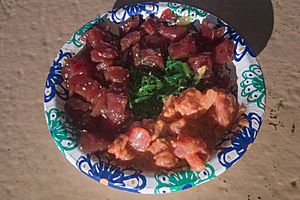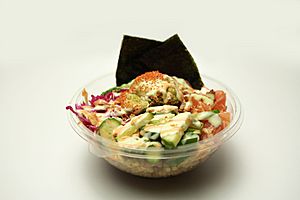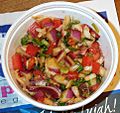Poke (Hawaiian dish) facts for kids
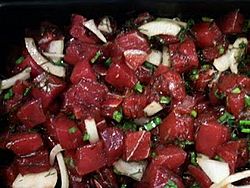
Ahi poke made with tuna, soy sauce, sea salt, green onions, Maui onions and rice limu
|
|
| Type | Salad |
|---|---|
| Course | Appetizer |
| Place of origin | Ancient Hawaii |
| Region or state | Hawaii |
| Main ingredients | Yellowfin tuna, sea salt, soy sauce, inamona, sesame oil, limu seaweed, chili pepper |
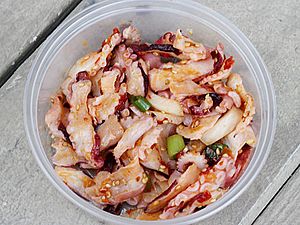
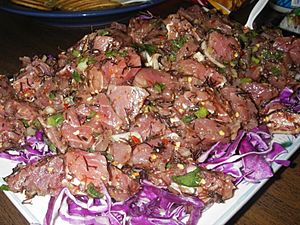
Poke (pronounced POH-keh) is a popular dish from Hawaii. The word "poke" means "to slice" or "cut into pieces" in the Hawaiian language. It's usually made with fresh, raw fish cut into cubes. Poke can be served as a small snack or a main meal. It's a very important part of Native Hawaiian food.
Traditionally, poke was made with aku (which is skipjack tuna) or heʻe (octopus). Today, you'll often find ahi poke, which uses yellowfin tuna. Sometimes, people also make poke with raw salmon or different kinds of shellfish. Unlike some other raw fish dishes, poke doesn't use citrus fruits to "cook" the fish.
Contents
The History of Poke
Poke has been a part of Hawaiian culture for a long time. Fishermen would season small pieces of their fresh catch to eat as a quick snack. They used simple, local ingredients like sea salt, candlenut, and limu (seaweed).
Around the 1970s, poke became even more popular. It started to be made with filleted raw fish. People would add Hawaiian salt, seaweed, and roasted, ground candlenut. This classic style of poke is still very common in Hawaii today.
Poke's Rise to Popularity
Starting around 2012, poke began to spread and become very popular in North America. Between 2014 and mid-2016, the number of Hawaiian restaurants that serve poke almost doubled!
Modern poke often comes in a "poke bowl." Instead of mixing all the ingredients together, they are often arranged neatly in a bowl. These modern versions might include new toppings like avocado, ponzu sauce, teriyaki sauce, mushrooms, crispy onions, pickled jalapeños, sriracha sauce, cilantro, pineapple, or cucumber.
A big difference is that traditional Hawaiian poke is usually pre-marinated. But the newer "mainland" style poke is often prepared with sauces right when you order it. Many modern poke places are "fast casual" restaurants. This means you can choose exactly what you want in your bowl, from the base (like rice) to the type of fish and marinade. While other seafood is used, ahi tuna is still the most popular choice.
There's even a three-day "I Love Poke" festival that celebrates this amazing dish and all its different styles!
What's in Poke?
Poke started as a simple snack for fishermen. They used what was available to them. Over time, Japanese and other Asian cooking styles have greatly influenced poke seasonings.
Common ingredients in poke include:
- Soy sauce
- Green onions
- Sesame oil
- Furikake (a mix of dried fish, sesame seeds, and dried seaweed)
- Chopped fresh or dried chili pepper
- Limu (seaweed)
- Sea salt
- Inamona (roasted, crushed, and salted candlenut)
- Fish eggs
- Wasabi
- Maui onions
Some poke variations might also include cured heʻe (octopus), other kinds of raw tuna, raw salmon, or different types of shellfish.
Traditional Hawaiian poke often has cubed raw fish, Maui onions, inamona, limu, soy sauce, green onions, or sesame oil.
Similar Dishes Around the World
Poke is like other raw fish salads found in Polynesian countries. For example:
- Ika mata in the Cook Islands
- Kokoda in Fiji
- Oka in Samoa
- 'Ota 'ika in Tonga
A very similar dish is kinilaw from the Philippines. It's sometimes called "Philippine ceviche." Kinilaw is usually raw diced fish marinated in citrus juice, sour fruits, or vinegar. It can also include coconut milk. This dish has been around for a very long time in the Philippines.
The Ilocano dish poqui poqui from the Philippines might have gotten its name from poke. This happened when many Ilocano sugarcane workers moved to Hawaii during the American colonization of the Philippines. However, poqui poqui is actually a scrambled egg dish with grilled eggplants and tomatoes, so it's very different from poke!
Other raw fish dishes similar to poke that you might find in Europe include fish carpaccio and fish tartare. In Korea, there's hoe-deopbap, which is marinated raw tuna served over rice. Peru has ceviche. Japan has sashimi, which is raw seafood. Other Japanese dishes like zuke don (cured fish over rice) and kaisendon (a more fancy version with extra toppings) are also similar.
See also
 In Spanish: Poke para niños
In Spanish: Poke para niños
Images for kids


